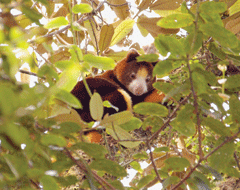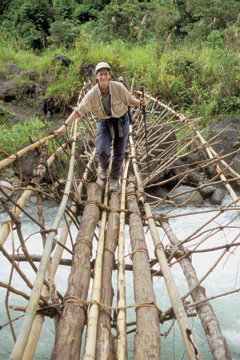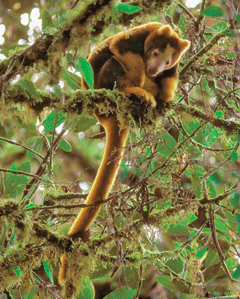Chasing Kangaroos
Air Date: Week of July 6, 2007

A tree kangaroo at home in the Cloud Forest in Papua, New Guinea. (Photo: Nic Bishop)
Yes Virginia, there are, in fact, ten different kinds of tree kangaroos. Author Sy Montgomery traveled with scientist Lisa Dabek to the ancient cloud forest of Papua New Guinea in search of the Matschie’s Tree Kangaroo. They get up close and personal with this tree-hugging marsupial in the new children’s book “Quest for the Tree Kangaroo"
Transcript
CURWOOD: If you were to look up in a tree and see a kangaroo, you might jump out of your skin in surprise. What’s a kangaroo doing in a tree? Well, if it’s a tree kangaroo, it’s probably making itself right at home. Not much is known about the elusive tree kangaroo, but scientist Lisa Dabek hopes to change that.
She’s been researching these teddy bear-like tree climbers and working to conserve the ancient forests of Papua New Guinea that one species of these high altitude marsupials calls “home.” On her last field expedition, Lisa Dabek brought along author Sy Montgomery. Sy wrote a children’s book about their adventure called “Quest for the Tree Kangaroo.”
Sy and Lisa, welcome to Living on Earth.
MONTGOMERY: Thanks for having us.
DABEK: Thank you, it’s great to be here.
CURWOOD: So, Sy, what’s a tree kangaroo look like?
MONTGOMERY: Oh my gosh. It looks like something that Dr. Seuss would have made up if he was working with a manufacturer of stuffed toys.
CURWOOD: (laughs)
MONTGOMERY: It is just the most adorable thing you’ve ever seen. And it has these pert upright ears. It has a white snout with a lovely little pink nose. It has a long golden tail. And it has a lemon yellow or white belly and great big sweet eyes. Unbelievably cute. And it’s about the size of a great big raccoon.
CURWOOD: Sy, when you first went into the cloud forest where these tree kangaroos are at home, what was it like? What did you see? What is one of these cloud forests like?
MONTGOMERY: Oh, man. It’s a gorgeous, gorgeous place. I like to tell people it’s like what heaven would look like if heaven had leaches.

Tree Kangaroos have been known to jump down 85 feet from their lofty perches in the cloud forest. (Photo: © Nic Bishop)
MONTGOMERY: And who knows, maybe they do. First of all to get there this is the most remote place I’ve ever been in my life of all the expeditions I’ve ever done. We had to hike for three days up into the cloud forest, up to 10,000 feet, where the forest is just shrouded in mist. It feels like a mystical magical place. And all the great trees are covered in moss. And the moss is laced with ferns and there’s great big vines hanging from everything, thick with moss. There’s orchids growing out of the trees. There’s rhododendrons growing out of the trees. Some of the flowers are huge and showy and some of them are small as a dress maker’s pin. And it looks just like the kind of place where you’d expect some hobbit or a troll to step out. But better than that, look who’s there: kangaroos in the trees.
CURWOOD: Now Lisa, these guys are hard to see, let alone monitor or track. What do we know about tree kangaroos? And what have you learned in studying them?
DABEK: Well, what we do know is that they are kangaroos. They are in the kangaroo family. They have pouches like regular kangaroos. But they live in the trees. And really nothing was known about them but from the work that we’ve been doing in Papua New Guinea we now know how they use the forest, how much forest they need to eat and to move around, to find their mates. We’re learning a lot of different things.
CURWOOD: Lisa how do you catch an animal that’s hard to see? And looking at the book that you guys put together, the photographs, seems to be perfectly happy at 85 feet up in the air.
DABEK: I know, it’s amazing. The villagers, the hunters, spot them. And then they cut down the brush underneath the tree. And they surround the tree. And then one of the men climbs a neighboring tree and starts making noise to frighten the animal. And the animal, when it wants to get away, it can leap down as far as 80 feet. And once the animal lands on the ground the hunters can grab the tail of the animal.

Lisa Dabek on her way to the Cloud Forest. (Photo: © Nic Bishop)
DABEK: I would not be able to do that.
CURWOOD: Now, you get the locals to help you catch them. And then what do you do once you’ve got a tree kangaroo?
DABEK: Well, we have a team of researchers and we take blood samples and measurements of the animals. And then we put radio collars on them to really get a good handle on the home range of the animals because that’s going to determine how much forest we really need to protect for healthy populations of animals. And then we’re also trying to get a good handle on their feeding ecology. So far we’ve documented that they eat over 90 species of plants. So we put the radio collars on but we’re also, these blood samples and fecal samples we’re able to look at the genetics of tree kangaroos. And that’s really important because very little is known about the taxonomy and classification of tree kangaroos. There was a new tree kangaroo species that was discovered in 1995, so only ten years ago. And for a large mammal that’s pretty exciting.
CURWOOD: Now, Sy, from your visit there how do the people in New Guinea view the tree kangaroos?
MONTGOMERY: Well, they think until Lisa told them, that everyone has tree kangaroos. That’s why they thought she was kind of nutty to want to see them. And they were thrilled to discover that they were the lucky ones, the only people in the world to have the species that Lisa studies, the Matchies, it only lives on one peninsula on one half of this one island in the whole world.
CURWOOD: Animals like this often have some folklore about them. What’s something special that folks there believe maybe a myth about the tree kangaroo?
MONTGOMERY: Well, they obviously think that tree kangaroos have some special power, because there’s one belief that if you think of the girl that you love before you let your arrow fly to shoot a tree kangaroo, at the moment the arrow pierces the animal’s body that’s when she will fall madly in love with you.
CURWOOD: Oh, my. That makes it tough on the tree kangaroos.
MONTGOMERY: Yeah, I know. It’s really a pretty rotten Valentine’s Day gift for them.
[LAUGHS]
CURWOOD: Lisa, what are the major challenges facing the tree kangaroo in terms of conservation?

A tree kangaroo at home in the Cloud Forest in Papua, New Guinea. (Photo: © Nic Bishop)
CURWOOD: What do you hope this book accomplishes, Sy?
MONTGOMERY: Well, a couple of things. First it’s a great adventure story about real science. This is like a National Geographic expedition. You know 44 people from three continents including quite a few local people hiking for three days to a totally unknown place to study an animal about which almost nothing is known. That’s just a great adventure story that makes science exciting to kids. And Lisa’s a great heroin. I mean she’s a fabulous scientist and a thing that few people know, but will after they read this book about her is that even though she’s working at ten thousand feet in this very strenuous environment, she has asthma and she has not let that stop her. She also didn’t let it stop her when other scientists said that what she wanted to do would never work. So that’s a great lesson for kids.
Another thing, because she’s amassed this large team of people from all over the world, some of us bring to this job talents you wouldn’t think could help conservation. So whatever talent you have you can bring this to help the world remain whole. But the one thing of course that I really want to get across the most, and you know this Steve, is that all of my books are really love stories. And these animals, you just look at them and immediately you just loose your heart. You love them. You can not help but want to know that they are going to be surviving half way around the world, even if you never even visit a zoo, you want to know that they are continuing to survive in this fairy tail, beautiful habitat of the cloud forest of Papua New Guinea.
CURWOOD: Thank you both for being with me.
MONTGOMERY: Thanks Steve, it was great.
DABEK: Thank you so much.
[MUSIC]
CURWOOD: Lisa Dabek is a scientist who’s worked with tree kangaroos in Papua New Guinea, and Sy Montgomery is the author of the book “Quest for the Tree Kangaroo.” To see photos of the tree kangaroo by Nic Bishop, go to our Web site, www.loe.org.
Links
“Quest for the Tree Kangaroo: An Expedition to the Cloud Forest of New Guinea” by Sy Montgomery
Living on Earth wants to hear from you!
Living on Earth
62 Calef Highway, Suite 212
Lee, NH 03861
Telephone: 617-287-4121
E-mail: comments@loe.org
Newsletter [Click here]
Donate to Living on Earth!
Living on Earth is an independent media program and relies entirely on contributions from listeners and institutions supporting public service. Please donate now to preserve an independent environmental voice.
NewsletterLiving on Earth offers a weekly delivery of the show's rundown to your mailbox. Sign up for our newsletter today!
 Sailors For The Sea: Be the change you want to sea.
Sailors For The Sea: Be the change you want to sea.
 The Grantham Foundation for the Protection of the Environment: Committed to protecting and improving the health of the global environment.
The Grantham Foundation for the Protection of the Environment: Committed to protecting and improving the health of the global environment.
 Contribute to Living on Earth and receive, as our gift to you, an archival print of one of Mark Seth Lender's extraordinary wildlife photographs. Follow the link to see Mark's current collection of photographs.
Contribute to Living on Earth and receive, as our gift to you, an archival print of one of Mark Seth Lender's extraordinary wildlife photographs. Follow the link to see Mark's current collection of photographs.
 Buy a signed copy of Mark Seth Lender's book Smeagull the Seagull & support Living on Earth
Buy a signed copy of Mark Seth Lender's book Smeagull the Seagull & support Living on Earth

